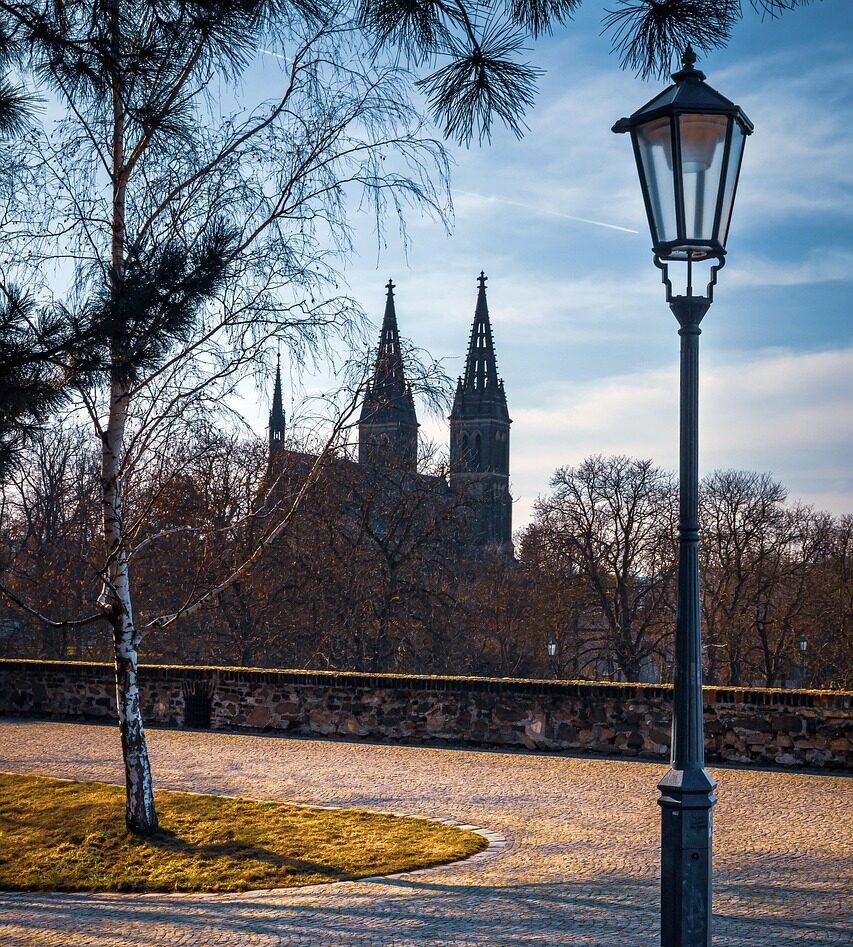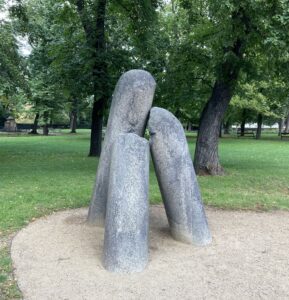
Perched high above the Vltava River, the ancient fortress of Vyšehrad stands like a spectral sentinel over Prague, its crumbling walls whispering secrets from a time long past. This is no mere historical site – this is a realm where the fabric of reality is thin, where the dead walk among the living, and where the night carries the echoes of forgotten voices. Vyšehrad is one of the oldest and most mystical places in Prague. It was once the seat of Czech kings before Prague Castle became the center of power. Even today, the fortress has an air of something ancient, something observant. Beneath its cobbled paths lie catacombs echoing with forgotten footsteps, and around its walls the wind often whispers in eerie tones.
There’s something unsettling about this place. Even in broad daylight, Vyšehrad has a strange feeling, a silence that is too deep, a feeling that you’re being watched. But when the sun goes down, when the shadows grow longer and the night air thickens with whispers, Vyšehrad changes. The wind carries laughter from another world, doors creak of their own accord, and those who wander alone often speak of unseen fingers brushing against their skin.
Legend has it that Vyšehrad was once the home of Princess Libuše, a sorceress ruler who prophesied that the great city of Prague would rise from the mists. But there are also darker tales associated with the site – tales of ghostly monks, phantom knights, and, of course, the Devil’s Stones. Want to learn more about Princess Libuše and the Devil’s Stones? Read on!
The world is full of strange and eerie objects, like stones that people whisper about in fearful tones, or items that have stood for generations, holding curses and forgotten stories. Among these eerie relics are the Devil’s Stones, giant rocks scattered across Europe, often tied to tales of dark deals, paranormal conflicts, and disturbing curses. But perhaps the most terrifying of all is located in the shadow of Prague’s Vyšehrad Fortress.
The Devil’s Stones – or “Čertovy kameny” as they are called in Czech – are scattered throughout Europe. Some can be found in Germany, Poland, and the British Isles, each with a sinister legend attached. Many of these stones are large, weather-worn monoliths whose origins have been lost to time. Some theories suggest they are remnants of glacial movements from the Ice Age, while others claim they are ancient sacrificial altars used by forgotten pagan cults.
The Devil’s Stones are often depicted in folklore as cursed artifacts left over from a botched supernatural deal, or as barriers thrown by demonic beings. According to some legends, they serve as markers between the realms of the mortal and the shadow.
But nowhere is their history more deeply intertwined with the spirit of the city than at Vyšehrad, where three ominous stones are said to have been thrown there by the devil himself.
Just outside the Church of St. Peter and Paul in Vyšehrad, three giant stones are arranged as if placed by an invisible hand. No one knows where they came from, but the locals have always believed that they are connected to something much more sinister than just natural rock formations.
Legend has it that years ago, a wise priest lived in Vyšehrad. He was known for his defiance of evil spirits and his wisdom. This angered the devil, who decided to destroy the priest. One night, hiding in the shadows, the devil offered a challenge: if he could move three stones from the village of Říp to Vyšehrad before the rooster crowed in the morning, he would take the priest’s soul.

The priest, being wise, agreed – but he had a plan. As the devil carried the first stone through the night sky, the priest slipped into the henhouse and woke the rooster. Startled, the rooster crowed early, breaking the eerie predawn silence.
When the devil heard this, he became confused. By the time he threw the third stone, it was too late. Realizing he’d been tricked, he became furious and disappeared in a puff of smoke, leaving the three stones behind.
These stones still exist today. People who dare touch them for too long report strange occurrences – whispers in the wind, sudden sickness, or, for the unfortunate, terrifying nightmares of a dark figure watching them. The stones are said to be cursed.
Locals and visitors alike report unsettling feelings near the Devil’s Stones at Vyšehrad. Some say they hear faint voices arguing in the dark at night. Others claim to feel a cold chill as they pass by, even in the middle of summer.

Though paranormal investigators have attempted to study the stones, their equipment often malfunctions when near them-compasses spin wildly, batteries die, and recorders pick up distorted whispers. One disturbing story tells of a man who touched the stones and then dreamt of a fiery landscape where a dark figure with burning eyes loomed over him, chanting his name in an ancient language.
Superstitions still surround the stones. Pregnant women are warned to stay away, lest they bring bad luck to their unborn child. Travelers are advised not to linger too long, and it’s said never to visit the stones at midnight – because that’s when the devil himself comes to count his losses.
Whether you believe in the legend or not, the Devil’s Stones at Vyšehrad remain a mystery. Are they mere geological formations placed there by natural forces? Or are they really the remnants of a supernatural wager, an eerie testament to the eternal battle between light and darkness?
One thing is certain: Vyšehrad holds its secrets close, and the Devil’s Stones stand as a silent warning to those who would seek to unravel them. Should you ever visit, tread lightly and listen carefully, for the stones may have a tale to whisper… if you dare to hear it.
In the misty lands of 8th-century Bohemia, where rivers echoed with lost songs and dense forests whispered secrets to the wind, lived a woman like no other. Princess Libuše, the youngest daughter of Krok, the legendary ruler of the Czechs, is a figure steeped in history and myth. Unlike her sisters, who excelled in more traditional roles, Libuše had the rare gift of foresight. She was said to have the ability to see beyond time and peer into the uncertain future.
According to the oldest records, Libuše ruled from the ancient fortress of Vyšehrad, a place that still stands above the Vltava River in modern-day Prague. She was known as a wise and just ruler who preferred diplomacy to war, knowledge to brute force. But it was her extraordinary visions that would define her reign and etch her name into the foundations of Czech lore.
One day, standing on the heights of Vyšehrad, she uttered a prophecy that would change the fate of her people forever:
“I see a great city, whose glory will touch the stars. In a place where a man is carving the threshold of his home, there shall rise a grand castle, and from it, the city of Prague will grow.”
Following her vision, she sent her soldiers to find the site and they placed the first stones of what would become the city of Prague in a humble place where a carpenter was hewing the threshold (práh in Czech). Libuše’s status as the mother of the Czech nation was cemented throughout history by this act alone. But history is rarely so simple, and the shadows of Vyšehrad hide mysteries of a much deeper nature.
Libuše’s supernatural abilities were both a blessing and a burden. Her people questioned the authority of a woman, especially one with the gift of sight, even though she ruled wisely. Feeling that only a man could lead Bohemia to prosperity, the chieftains petitioned for a male ruler. After accepting their request with sadness in her heart, Libuše had a vision of her future husband, Přemysl, a simple plowman from Stadice. After she sent her messengers to bring him to Vyšehrad, the Přemyslid dynasty, which would rule Bohemia for generations to come, was established.
But not all of Libuše’s stories end in triumph. Some say that as she stepped down from her throne, she uttered a final prophecy, one filled with ominous foreboding. The kingdom, she warned, would prosper, but in its wealth it would also be doomed to suffer. Blood would be shed and great calamities would befall its people. Some whispered that as she spoke these words, storm clouds gathered over Vyšehrad, darkening the sky in an unnatural twilight.
After her departure, her presence never really faded. There was a strange uneasiness in the air of Vyšehrad, as if her spirit had never left its walls.
There are those who believe that Libuše’s spirit still lingers in Vyšehrad, watching over the city she foresaw. Visitors often report an eerie silence at dusk, when the air grows heavy and the stones themselves seem to hum with an ancient energy. Some claim to see the ghostly figure of a woman in flowing robes standing at the edge of the cliffs, gazing out over Prague as if searching for something lost to time.

According to one terrifying tale, a traveler saw a pale woman walking in the middle of the night over the ramparts of the old fortress. Her face was hidden by shadows as she glided with unearthly grace. She turned as he called out to her, but instead of seeing what should have been her eyes, he saw nothing. Nothing but a void that swallowed the moonlight. The traveler fled, but the sound of her voice followed him, singing a melody that chilled his blood in a language he didn’t understand.
Another story tells of a hidden chamber beneath Vyšehrad, where the treasures of Libuše are said to remain untouched. According to the legend, the chamber will open only when the country is in its greatest danger, revealing riches beyond imagination – but at a terrible price. Some believe that those who have attempted to find the Chamber have vanished without a trace, their desperate cries echoing in the darkness below.
The legend of Libuše continues to this day. Historians may argue over the details, questioning how much of her story is truth and how much is myth. But one thing is certain: her presence in Prague is more than just a tale from the past. Every shadowy corner of Vyšehrad, every whisper of the wind through its ancient ruins, speaks of something unseen, something waiting.
So consider this: maybe, just maybe, Princess Libuše is still watching as the mist sweeps over Prague and the ancient stones of Vyšehrad seem to breathe with a life of their own. Perhaps she will rise again, emerging from the shadows of mythology into the real world in Bohemia’s hour of greatest need. Or perhaps, as you wander the dark paths of Vyšehrad alone, it will whisper your name.
Would you answer?
Vyšehrad is more than history – it is a haunted relic, a place where the past refuses to rest. It is a fortress of ghosts, of whispers in the dark, of shadows that move when no one is looking. Those who visit can feel the chill of unseen eyes upon them, the weight of centuries on their shoulders.
Some come for adventure, others for proof of the supernatural. But all who leave Vyšehrad carry something with them – a lingering sense of unease, a whisper that follows them into the night, a feeling that maybe, just maybe, the fortress is not finished with them.
For those who dare, Vyšehrad awaits. But tread carefully, for the dead do not sleep, and the past is always watching.
Written by Ana Nežmah